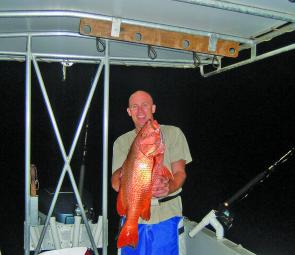Cyclone Yasi has left its mark around Cairns, but nothing like further south. On the upside, it has left the fishing red hot. By late February/early March, the bait schools were so thick that it was common to find massive schools boiling on the surface and not a bird in sight. There were just too many bait boils to choose from.
More bait means more predators, but sometimes they can be too full, so working out the feeding times is crucial. The Angler’s Almanac certainly helps in this endeavour.
April usually brings the sunshine, with the tailing off of the wet season and the gradual transition to cool, clear, autumn weather. Depending on the weather gods, it can still be stinking hot, like last April, or the sou’easterly trade winds have started to establish themselves ready for winter. The warmer weather tends to coincide with extended periods of calm winds, which will see the reef fishos smiling but the drainos cursing the heat and sandflies.
The fishing has been red hot at the reef since Yasi and, with autumn’s transition to cooler weather, make the most of any calm weather periods.
Consistency can be an issue at the reef this month. There are usually plenty of variety on offer but sometimes no real runs of any species. Night fishing tends to be less risky, with the storm season waning and the reds starting to feed on the deep water rubble grounds. Over nighting, or out late afternoon and home by midnight, are great options when the winds are playing the game. Waiting until daylight to head home can result in a rough ride in, banging into the sou’westerly that invariably establishes itself in the early hours, blowing out of Trinity Inlet.
Night fish will consist mostly of largemouth and smallmouth nannygai, spangled emperor, gold spot trevally, slatey bream, bludger trevally and red emperor. Generally the deep water, over 40m, is the most productive but the downside can be the presence of sharks, which have caused chaos nailing too many prized fish. When the sharks are feeding, bludger trevally, Chinaman and slatey bream always seem to make it to the boat but any decent red fish gets nailed as soon as it’s off the bottom.
The small boat brigade should find a variety of fish on the chew, including queenfish, trevally, jacks, grunter, flathead, barra and bream. The extended wet has brought a lot of fresh new food for the fish, making them quite active.
Barra will still be in top gear if it’s an extended summer, like last year. To date it has been a fantastic barra season and with luck, the pink eyed trophies will bite well into the cooler months. Try all the usual haunts and if the water has cooled a tad, shift to trolling deep diving lures over good bottom structure.
There has been reports of quality grunter being caught out on the hospital flats, so target them on the big lead up tides to the new moon over the first weekend in April, then again on the weekend of the 16 and 17 in the lead up to the monster full moon tides. As a rule, they bite to the top of the tide and then fade off rapidly as the tide starts to drop.
Queenfish and trevally species will start to appear in the estuaries and inlet as the water clears, so focus your effort for them on the big incoming tides before the new and full moons, if the water has cleared by then.
Pelagics generally like a high salt content in the estuaries before they push into the systems. Mangrove jack will be in the heavy country and blue and king salmon will also be on the chew, with the flats around the inlet and river mouths the best bet for them.
The red devils will be up the creeks, around any patch of heavy cover. Luring the turn of the low tide, which coincides with dawn and dusk can produce some awesome jack action, with the odd barra crashing in on the party.
Salmon will be around the flats, estuaries and creek mouths in the dirtier water and especially where there is concentrations of prawns or baitfish. As the water cools, bream will become more active, especially around the man-made structures and rock walls, making it easier for land-based anglers to get in on the action.
Keep an eye out along the beaches and estuary/inlet mouths for prawns, which can still run in April. Even a small number of prawns moving will attract predators, so any prawn activity is worth fishing around, if there isn’t enough for a feed. The last of the run-out tide around the mouths of small creeks and drains is a great place for prawns and their predators to gather.
In Cairns Inlet the boat traffic can make these spots a bit hit and miss but in quieter systems they are well worth a double dip. Sneak in, preferably under electric or man power, and flick a few lures around before digging out the cast net. A barra, jack or salmon washed down with the feed of prawns makes for a dream dinner.
Reads: 2018
Andrew Carter from Brisbane with a magnificent mangrove jack taken off a Cairns’ reef.

Eileen Macri with a trophy trout caught off Cairns.

Millpond calm dawns are a rare occurrence at the reef, especially in April.




